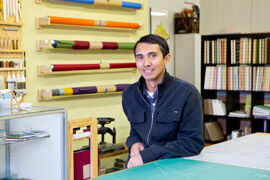
Art For Nonartists

Chicago’s Albany Park is one of the most diverse neighborhoods in the United States, according to the city’s official tourism website. It is a working-class neighborhood—its main street lined with Korean, Middle Eastern, Thai, Indian, and Mexican stores and restaurants. And it is Albany Park, with its unique blend of culture and everyday life that inspires Regin Igloria’s (BFA 1996) art practice.
At first, Igloria did not ask for this particular muse. He was born in Manila, Philippines, and moved with his family to Albany Park as a child. He grew up there but imagined living a different lifestyle. “I felt stuck there. My parents didn’t have enough money to take us on typical family vacations so we had to explore within the neighborhood,” he explains. “My work is always about travelling and movement elsewhere—starting in one place and trying to find happiness in another.”
His current exhibition at Brushwood Gallery in the Ryerson Woods, This Offer Won’t Last, explores the idea of outdoor culture and its relationship to wealth. The work features a range of drawn and collaged imagery culled from personal travel photographs and tweaked Patagonia catalogs: images of expensive camping gear that is out of reach for many young people living in the city, which also makes the outdoors off limits to them.
“I’m really interested in class dynamics—who can afford to travel and who can afford to buy things that supposedly make you happy,” says Igloria.
In addition to his fine art, Igloria runs North Branch Projects, a project space in Albany Park that offers community bookbinding sessions six days a week. After earning his BFA at SAIC, Igloria received his MFA from Rhode Island School of Design. Unlike many of the students in his graduate program, he decided to return home rather than move to New York upon graduation. He now lives above North Branch, just five blocks away from his parents’ house.
“In order to make some relevant impact with your art, you have to put yourself in a situation where the work you’re creating is going to reach people who wouldn’t see it in a gallery or a museum. It doesn’t have the same kind of depth and reach [in a gallery] as it does when shared with the community where you’re from,” Igloria says.
He finds inspiration and insight in his conversations with community and family members who do not have formal art school training and whom he considers his most important audience, something he encourages other artists to seek as well.
Through Igloria’s Co-op internship at SAIC, he learned how far art could take him and why it was so important. He now mentors students by hiring one Co-op student each semester. One of his interns, Moki Tantoco, has even formed a student group at the school called North Branch at SAIC. “My goal is to introduce every first-year SAIC student to North Branch so they can learn to make a sketchbook their first semester,” says Igloria.
As his exhibition wraps up this month and Chicago Artists Month draws to a close, Igloria plans to continue working through North Branch to build new relationships and “see how it evolves.”
